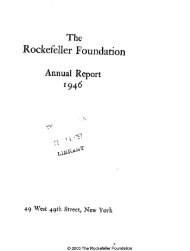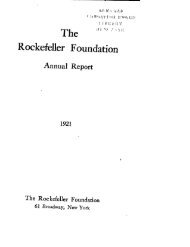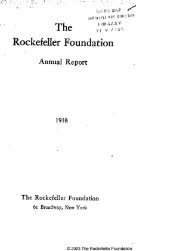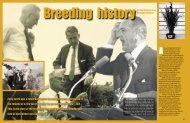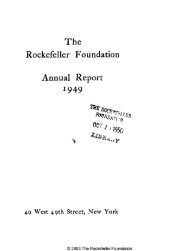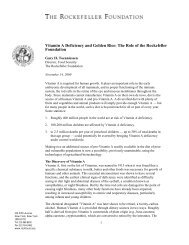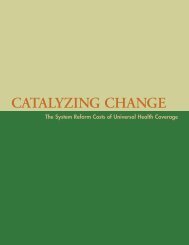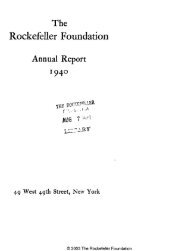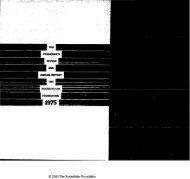- Page 1 and 2:
The Rockefeller Foundation Annual R
- Page 3 and 4:
CONTENTS PAGE FOREWORD xiii REPORT
- Page 5 and 6:
ILLUSTRATIONS PAGE Surveyor making
- Page 7 and 8:
THE ROCKEFELLER FOUNDATION MEMBERS,
- Page 9 and 10:
To the Members of The Rockefeller F
- Page 11 and 12:
FOREWORD XV of the exact sciences u
- Page 13 and 14:
REPORT OF THE SECRETARY © 2003 The
- Page 15 and 16:
SECRETARY'S REPORT The members and
- Page 17 and 18:
SECRETARY'S REPORT Statement of Fun
- Page 19 and 20:
SECRETARY'S REPORT 7 Humanities Edu
- Page 21 and 22:
SECRETARY'S REPORT University of Ge
- Page 23 and 24:
SECRETARY'S REPORT n Land and Build
- Page 25 and 26:
SECRETARY'S REPORT 13 PUBLIC HEALTH
- Page 27 and 28:
INTERNATIONAL HEALTH DIVISION V *
- Page 29 and 30:
CONTENTS PAGE PUBLIC HEALTH General
- Page 31 and 32:
INTERNATIONAL HEALTH DIVISION1 Publ
- Page 33 and 34:
INTERNATIONAL HEALTH DIVISION 21 th
- Page 35 and 36:
INTERNATIONAL HEALTH DIVISION 2J st
- Page 37 and 38:
INTERNATIONAL HEALTH DIVISION 25 Sk
- Page 39 and 40:
\j& to// yr^i^ ,&
- Page 41 and 42:
i I *Ji! •m A ''V Photograph Exci
- Page 43 and 44:
INTERNATIONAL HEALTH DIVISION 3! pl
- Page 45 and 46:
INTERNATIONAL HEALTH DIVISION 33 to
- Page 47 and 48:
INTERNATIONAL HEALTH DIVISION 35 pr
- Page 49 and 50:
INTERNATIONAL HEALTH DIVISION 37 th
- Page 51 and 52:
INTERNATIONAL HEALTH DIVISION 39 A
- Page 53 and 54:
Photograph Excised Here Students' l
- Page 55 and 56:
,' ! I ill "I ,| '' '! Photograph E
- Page 57 and 58:
INTERNATIONAL HEALTH DIVISION 45 mi
- Page 59 and 60:
INTERNATIONAL HEALTH DIVISION 47 am
- Page 61 and 62:
INTERNATIONAL HEALTH DIVISION 49 or
- Page 63 and 64:
INTERNATIONAL HEALTH DIVISION 5! wi
- Page 65 and 66:
INTERNATIONAL HEALTH DIVISION £J C
- Page 67 and 68:
INTERNATIONAL HEALTH DIVISION 55 of
- Page 69 and 70:
Photograph Excised Here Children en
- Page 71 and 72:
p'&-•> Photograph Excised Here Cl
- Page 73 and 74:
INTERNATIONAL HEALTH DIVISION 6l in
- Page 75 and 76:
INTERNATIONAL HEALTH DIVISION 63 Fr
- Page 77 and 78:
THE MEDICAL SCIENCES © 2003 The Ro
- Page 79 and 80:
CONTENTS PAGE INTRODUCTION 69 PROGR
- Page 81 and 82:
THE MEDICAL SCIENCES During 1935 Th
- Page 83 and 84: THE MEDICAL SCIENCES JI atry. In 19
- Page 85 and 86: THE MEDICAL SCIENCES 73 ordinary be
- Page 87 and 88: THE MEDICAL SCIENCES 75 The Departm
- Page 89 and 90: THE MEDICAL SCIENCES 77 made an app
- Page 91 and 92: THE MEDICAL SCIENCES 79 National Ho
- Page 93 and 94: THE MEDICAL SCIENCES 81 patients ar
- Page 95 and 96: THE MEDICAL SCIENCES 83 so closely
- Page 97 and 98: THE MEDICAL SCIENCES 85 cal and lab
- Page 99 and 100: THE MEDICAL SCIENCES 87 and states
- Page 101 and 102: THE MEDICAL SCIENCES 89 orated prec
- Page 103 and 104: THE MEDICAL SCIENCES 9! During the
- Page 105 and 106: THE MEDICAL SCIENCES 93 epidemiolog
- Page 107 and 108: THE MEDICAL SCIENCES- 95 search in
- Page 109 and 110: THE MEDICAL SCIENCES 97 of its rece
- Page 111 and 112: THE MEDICAL SCIENCES 99 them worked
- Page 113 and 114: THE MEDICAL SCIENCES IOI and hypers
- Page 115 and 116: THE MEDICAL SCIENCES 31,000 for res
- Page 117 and 118: THE MEDICAL SCIENCES of the brain,
- Page 119 and 120: THE MEDICAL SCIENCES 1OJ Miscellane
- Page 121 and 122: THE MEDICAL SCIENCES 109 The confer
- Page 123 and 124: THE MEDICAL SCIENCES III Summary of
- Page 125 and 126: THE MEDICAL SCIENCES FORMER PROGRAM
- Page 127 and 128: THE MEDICAL SCIENCES 115 Institute
- Page 129 and 130: THE MEDICAL SCIENCES Special resear
- Page 131 and 132: THE NATURAL SCIENCES © 2003 The Ro
- Page 133: CONTENTS PAGE INTRODUCTORY STATEMEN
- Page 137 and 138: THE NATURAL SCIENCES 125 psychical
- Page 139 and 140: THE NATURAL SCIENCES 127 human gene
- Page 141 and 142: THE NATURAL SCIENCES highly valuabl
- Page 143 and 144: THE NATURAL SCIENCES IJI part of th
- Page 145 and 146: THE NATURAL SCIENCES 133 terials. D
- Page 147 and 148: THE NATURAL SCIENCES of the structu
- Page 149 and 150: THE NATURAL SCIENCES 137 eases indi
- Page 151 and 152: THE NATURAL SCIENCES 139 have been
- Page 153 and 154: Photograph Excised Here w^ Corner o
- Page 155 and 156: I I •$ w ii'if'i Photograph Excis
- Page 157 and 158: THE NATURAL SCIENCES 145 ords taken
- Page 159 and 160: THE NATURAL SCIENCES 147 study of t
- Page 161 and 162: THE NATURAL SCIENCES 149 nesium met
- Page 163 and 164: ,'r THE NATURAL SCIENCES 151 far co
- Page 165 and 166: THE NATURAL SCIENCES 153 film study
- Page 167 and 168: THE NATURAL SCIENCES 155 per was ch
- Page 169 and 170: THE NATURAL SCIENCES 157 mechanism
- Page 171 and 172: THE NATURAL SCIENCES 159 Babcock no
- Page 173 and 174: THE NATURAL SCIENCES l6l leadership
- Page 175 and 176: THE NATURAL SCIENCES 163 sion quest
- Page 177 and 178: THE NATURAL SCIENCES 165 system. In
- Page 179 and 180: THE NATURAL SCIENCES 167 appropriat
- Page 181 and 182: THE NATURAL SCIENCES 169 1936 and 1
- Page 183 and 184: THE NATURAL SCIENCES was based on t
- Page 185 and 186:
Photograph Excised Here Photograph
- Page 187 and 188:
•'l < 4 ft K ''•, |i V ;tl 1 '
- Page 189 and 190:
THE NATURAL SCIENCES 177 sciences a
- Page 191 and 192:
THE NATURAL SCIENCES Two appropriat
- Page 193 and 194:
THE NATURAL SCIENCES l8l used durin
- Page 195 and 196:
THE NATURAL SCIENCES 183 Support to
- Page 197 and 198:
THE NATURAL SCIENCES 185 Long Islan
- Page 199 and 200:
THE NATURAL SCIENCES STAFF DURING 1
- Page 201 and 202:
THE SOCIAL SCIENCES © 2003 The Roc
- Page 203 and 204:
CONTENTS PAGE INTRODUCTION 193 GENE
- Page 205 and 206:
THE SOCIAL SCIENCES In 1935 the Fou
- Page 207 and 208:
THE SOCIAL SCIENCES 195 A. General
- Page 209 and 210:
THE SOCIAL SCIENCES 197 be final an
- Page 211 and 212:
THE SOCIAL SCIENCES 199 actually in
- Page 213 and 214:
THE SOCIAL SCIENCES 2OI cialized br
- Page 215 and 216:
THE SOCIAL SCIENCES 2OJ Besides mak
- Page 217 and 218:
THE SOCIAL SCIENCES 1O$ S0MMAR7 OF
- Page 219 and 220:
THE SOCIAL SCIENCES 2QJ for the app
- Page 221 and 222:
THE SOCIAL SCIENCES 209 The America
- Page 223 and 224:
THE SOCIAL SCIENCES 211 support ove
- Page 225 and 226:
THE SOCIAL SCIENCES 213 on by the H
- Page 227 and 228:
THE SOCIAL SCIENCES 215 ization. Th
- Page 229 and 230:
THE SOCIAL SCIENCES 2iy gram direct
- Page 231 and 232:
THE SOCIAL SCIENCES official organi
- Page 233 and 234:
THE SOCIAL SCIENCES 221 Institute o
- Page 235 and 236:
THE SOCIAL SCIENCES 223 and publica
- Page 237 and 238:
THE SOCIAL SCIENCES 225 than was fo
- Page 239 and 240:
THE SOCIAL SCIENCES 227 lems in Eur
- Page 241 and 242:
THE SOCIAL SCIENCES 22p grants in 1
- Page 243 and 244:
THE SOCIAL SCIENCES 231 John Casimi
- Page 245 and 246:
THE SOCIAL SCIENCES 233 proved publ
- Page 247 and 248:
THE SOCIAL SCIENCES units and publi
- Page 249 and 250:
THE SOCIAL SCIENCES £37 courses we
- Page 251 and 252:
THE SOCIAL SCIENCES 239 ing the soc
- Page 253 and 254:
THE SOCIAL SCIENCES 24! son agency
- Page 255 and 256:
THE SOCIAL SCIENCES 243 first exper
- Page 257 and 258:
THE SOCIAL SCIENCES 245 program of
- Page 259 and 260:
THE SOCIAL SCIENCES £47 economic r
- Page 261 and 262:
THE SOCIAL SCIENCES £49 scientific
- Page 263 and 264:
THE SOCIAL SCIENCES 251 formerly co
- Page 265 and 266:
THE SOCIAL SCIENCES 253 The sum of
- Page 267 and 268:
THE SOCIAL SCIENCES STAFF DURING 19
- Page 269 and 270:
THE HUMANITIES © 2003 The Rockefel
- Page 271 and 272:
CONTENTS PAGE INTRODUCTION 261 AMER
- Page 273 and 274:
THE HUMANITIES In accord with polic
- Page 275 and 276:
THE HUMANITIES 263 upon the world t
- Page 277 and 278:
Photograph Excised Here at the Broo
- Page 279 and 280:
•Will fill, i i H : ',"> I ' ' \"
- Page 281 and 282:
THE HUMANITIES 269 but also on thos
- Page 283 and 284:
THE HUMANITIES 27! 1935, 410 teache
- Page 285 and 286:
THE HUMANITIES 273 school and coope
- Page 287 and 288:
THE HUMANITIES 275 for use during t
- Page 289 and 290:
THE HUMANITIES 277 been pledged to
- Page 291 and 292:
THE HUMANITIES 279 checking with li
- Page 293 and 294:
Photograph Excised Here Scene from
- Page 295 and 296:
to • i Photograph Excised Here ^
- Page 297 and 298:
THE HUMANITIES 285 ies of material
- Page 299 and 300:
THE HUMANITIES 287 within a short w
- Page 301 and 302:
THE HUMANITIES 289 Japan. As an out
- Page 303 and 304:
THE HUMANITIES 1935, to August 31,
- Page 305 and 306:
THE HUMANITIES 293 use of foreign s
- Page 307 and 308:
THE HUMANITIES 295 of material on O
- Page 309 and 310:
THE HUMANITIES length of term, such
- Page 311 and 312:
THE HUMANJTIES 299 in the humanitie
- Page 313 and 314:
THE HUMANITIES 301 B. Chapin during
- Page 315 and 316:
THE HUMANITIES opments of Christian
- Page 317 and 318:
THE HUMANITIES 305 tine, and the ar
- Page 319 and 320:
THE HUMANITIES 307 University of Ch
- Page 321 and 322:
THE HUMANITIES 309 with phonetic tr
- Page 323 and 324:
THE HUMANITIES 311 Library of Congr
- Page 325 and 326:
THE HUMANITIES 313 Johns Hopkins Un
- Page 327 and 328:
THE HUMANITIES STAFF DURING 1935 DI
- Page 329 and 330:
CHINA PROGRAM © 2003 The Rockefell
- Page 331 and 332:
CONTENTS PAGE INTRODUCTION 321 NORT
- Page 333 and 334:
CHINA PROGRAM The interest of The R
- Page 335 and 336:
CHINA PROGRAM appropriation of Loca
- Page 337 and 338:
In terior of the insectary where th
- Page 339 and 340:
f»r m 4>.u Weighing ,. i wheat see
- Page 341 and 342:
CHINA PROGRAM 329 Public Affairs du
- Page 343 and 344:
Photograph Excised Here * © 2003 T
- Page 345 and 346:
Photograph Excised Here Above: Stud
- Page 347 and 348:
CHINA PROGRAM 335 operation*has bee
- Page 349 and 350:
Photograph Excised Here of the Chin
- Page 351 and 352:
IMS Photograph Excised Here Politic
- Page 353 and 354:
CHINA PROGRAM 34! ture has received
- Page 355 and 356:
CHINA PROGRAM 343 It is anticipated
- Page 357 and 358:
THE CHINA PROGRAM STAFF DURING 1935
- Page 359 and 360:
REPORT OF THE TREASURER © 2003 The
- Page 361 and 362:
TREASURER'S REPORT In the following
- Page 363 and 364:
TREASURER'S REPORT 351 The financia
- Page 365 and 366:
TREASURER S REPORT 353 EXHIBIT A BA
- Page 367 and 368:
EXHIBIT C CONSOLIDATED STATEMENT OF
- Page 369 and 370:
EXHIBIT D APPROPRIATIONS MADE DURIN
- Page 371 and 372:
Library Association, London, Englan
- Page 373 and 374:
University of Pennsylvania, Philade
- Page 375 and 376:
State Central School of Nursing, Bu
- Page 377 and 378:
California Institute of Technology,
- Page 379 and 380:
University of Szeged, Hungary, Depa
- Page 381 and 382:
Geophysical research (RF 31134, 351
- Page 383 and 384:
University of Amsterdam, Netherland
- Page 385 and 386:
University of Paris, France Radium
- Page 387 and 388:
Land and Buildings Chulalongkorn Un
- Page 389 and 390:
Institute of Economic and Social Re
- Page 391 and 392:
Geneva Research Center, Switzerland
- Page 393 and 394:
Technical Institute, Graz, Austria
- Page 395 and 396:
Grants in Aid Humanities (RF 33095,
- Page 397 and 398:
Social Science Research Council, Ne
- Page 399 and 400:
Chinese Ministry of Education, Nank
- Page 401 and 402:
PUBLIC HEALTH Central Medical Schoo
- Page 403 and 404:
Treasurer's Office 1934 (RF33118)..
- Page 405 and 406:
EXHIBIT F INTERNATIONAL HEALTH DIVI
- Page 407 and 408:
Philippine Islands 1934 (IH 33136)
- Page 409 and 410:
Minnesota 1935-36 (IH 35038,3S051)
- Page 411 and 412:
Divisions of Public Health Nursing
- Page 413 and 414:
West Indies Jamaica. Bureau of Heal
- Page 415 and 416:
Nicaragua 1933-34 (IH 33076,34040)
- Page 417 and 418:
Puerto Rico 1932-36 (IH 32072,33115
- Page 419 and 420:
Training of Health Workers United S
- Page 421 and 422:
Investigations and surveys United S
- Page 423 and 424:
Investigations and Surveys United S
- Page 425 and 426:
Investigations Bolivia 1932-33 (IH
- Page 427 and 428:
Survey 1934 (IH 33125} ............
- Page 429 and 430:
Virginia Study of scarlet fever 193
- Page 431 and 432:
EXHIBIT G SUMMARY OF PRIOR OBLIGATI
- Page 433 and 434:
EXHIBIT I H STATEMENT OF PRINCIPAL
- Page 435 and 436:
EXHIBIT K SCHEDULE OF SECURITIES ON
- Page 437 and 438:
Chicago, Rock Island, & Pacific Ry.
- Page 439 and 440:
Kansas City-Terminal Ry. First Mort
- Page 441 and 442:
Pennsylvania R.R. General Mortgage
- Page 443 and 444:
NAME STOCKS Atcbison, Topeka, & San
- Page 445 and 446:
The Standard Oil Co. (Ohio) Cumulat
- Page 447 and 448:
INDEX © 2003 The Rockefeller Found
- Page 449 and 450:
INDEX PAGE Adrian, E. D 102 Aedes a
- Page 451 and 452:
PAGE Australia Fellowships. 98,204
- Page 453 and 454:
PAGE Brown University 144,367 Bruss
- Page 455 and 456:
PAGE Chekiang, National University
- Page 457 and 458:
PAGE Research and field training in
- Page 459 and 460:
PAGE Fellowships 98,177,178,204 Res
- Page 461 and 462:
PAGE Public health administration 3
- Page 463 and 464:
PAGE Grant, John B 62,345 Grants in
- Page 465 and 466:
PAGE Hughes, Thomas P. 62 Humanitie
- Page 467 and 468:
PAGE Iowa City 7,8,13,154,182,185,3
- Page 469 and 470:
PAGE Krogh, August 129 Kumm, Henry
- Page 471 and 472:
PAGE Manitoba,, Canada Local health
- Page 473 and 474:
PAGE Minot, G. R 105 Mississippi Co
- Page 475 and 476:
PAGE Netherlands Fellowships 98,99
- Page 477 and 478:
PAGE Ohio 6,7,117,232,254,271,309,3
- Page 479 and 480:
PAGE Division of public health nurs
- Page 481 and 482:
PAGE For the natural sciences 11, 1
- Page 483 and 484:
PAGE Scott, J. Allen 63 Seattle, Wa
- Page 485 and 486:
PAGE Statistical Institute of Econo
- Page 487 and 488:
PAGE Tuberculosis studies 21,22,45-
- Page 489 and 490:
PAGE Washington, D. C 6,9,10,11,12,
- Page 491:
PAGE Yugoslavia Fellowships 408 Pub



